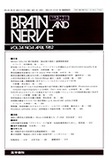Japanese
English
- 有料閲覧
- Abstract 文献概要
- 1ページ目 Look Inside
抄録 局所脳虚血において脳に不可逆的な障害を生じるICBFの閾値に関しては多くの報告がある。しかし虚血により生じる脳浮腫とICBFとの関係は明らかではない。今回我々はネコ中大脳動脈閉塞モデルを用い水素クリアランス法によるICBFと,gradient columnによる局所脳水分含量を測定することにより,脳虚血,血行再開およびreactive hyperemiaの脳浮腫への影響を検索した。実験の結果,血行再開後のreactive hyperemiaは一般に脳浮上を増強すると,言われているが両者に明確な相関は認められなかった。むしろ血行再開後脳浮腫の発生および増悪は,虚血中ICBFが15〜20ml/100g/min以下に低下した皮質領域に限られた。この浮腫発生についての虚血中ICBFの閾値は既に報告されている不可逆的損傷のそれと良く一致した。
The correlation between the local cerebral blood flow (1CBF) and the specific gravity (SG) of the topographically corresponding cortical area was examined using a model of regional cerebral is-chemia by means of transorbital occlusion of the middle cerebral artery (MCA) in cats. Cats weredivided into the following experimental groups. Group A: two hours MCA occlusion followed by two hours recirculation; Group B: two hours MCA occlusion; Group C: four hours MCA occlusion. The 1CBF and the SG were measured by the use of hydrogen clearance method and gradient column, respectively. Two hours MCA occlusion resulted in a moderate drop in SG in the cortical areas where the ICBF decreased below 20 ml/100 g/min during ischemia (Group B). Four hours MCA oc-clusion in Group C resulted in a similar drop in SG. Two hours recirculation following two hours MCA occlusion in Group A, however, caused a remarkable drop in SG which was significantly greater than those in Group B and C. There was no correlation between the drop in SG and the level of post-ischemia 1CBF (reactive hyperemia) in Group A. Thus, the present study revealed i) that the development of cerebral edema as evi-denced by the drop in cortical SG was associated with an extreme reduction in 1CBF, ii) that recir-culation exerted a detrimental influence on the post-ischemic brain injury and iii) that the edema aggravation during recirculation was not necessarily dependent on the magnitude of reactive hyperemia. Based on the above results, it was suggested that the cause of edema aggravation following recircula-tion, namely the development of vasogenic edema, might reside in some chemical mechanism such as lipid peroxidation.

Copyright © 1982, Igaku-Shoin Ltd. All rights reserved.


